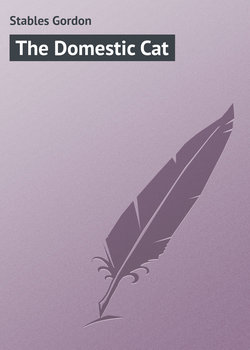Читать книгу The Domestic Cat - Stables Gordon - Страница 6
Chapter Six.
The Blue Cat; and Tabbies – Red, Brown, Spotted, and Silver
ОглавлениеThe Blue cat: just one word about this pretty creature before passing on to the Tabbies. Although she is called a blue cat, don’t fancy for a moment that ultramarine is anywhere near her colour, or himmel-blue, or honest navy serge itself. Her colour is a sad slate-colour; I cannot get any nearer to it than that.
Apart from her somewhat sombre appearance, this cat makes a very nice pet indeed; she is exceedingly gentle and winning, and I’m sure would do anything rather than scratch a child. But the less children have to do with her the better, for all that: for this simple reason – she is a cat of delicate constitution – all that ever I knew were so, at least, and I daresay my readers can corroborate what I say.
Merits. – Their extreme gentleness is one merit, and their tractability and teachability are others. A pure blue cat is very rare, and they are greatly prized by their owners.
Points. – 1. Size: They are rather under-sized, never being much larger than the pure tortoiseshell.
2. Head: The head is small and round, and the eyes are prettiest when of a beautiful orange-yellow. The nose should be tipped with black.
3. Pelage: Moderately long and delightfully soft and sheeny.
4. Colour: This is the principal point. It is, as I said, a nice cool, slate-grey, and, like the black cat, our blue pussy must be all one colour, without a hair of white anywhere. Even her whiskers must be of the same colour as her fur.
Points of the Blue Cat.
Size, 5.
Head, 5.
Pelage, 10.
Colour, 30.
Total, 50.
We now come to the Tabbies – the real old English cats – the playmates of our infant days and sharers of our oatmeal porridge. They are the commonest of all cats, and justly so, too, for there is hardly anything they don’t know, and nothing they can’t be taught, bar conic sections, perhaps, the Pons Asinorum, and a few trifles of that ilk. You will find a tabby cat wherever you go, and you will find her equally at home wherever she is – whether sitting on the footstool on the cosy hearthrug, singing duets with the tea-kettle; catching birds and rabbits in the woods, or mice in the barn; conducting a concert for your especial benefit on the neighbouring tiles at twelve o’clock at night; examining the flower seeds you lately sowed in the garden to see if they are budding yet; or locked, quite by accident, into the pigeon loft.
The first cat of the Tabby kind which claims our attention is the Red or Sandy Tabby.
This is a very beautiful animal, and quite worthy of a place in the best drawing-rooms in the land. Although they do not grow to the immense size of some of our brown tabbies, still they are better hunters, much fiercer, and of a hardier constitution. They much prefer out-of-door sport, and will attack and slay even the polecat and weasel; and instances have been known of their giving battle to the wild cat himself.
Merits. – They are the prettiest of pets, and the honestest of all cat kind. They are such good ratters that neither mice nor rats will frequent the house they inhabit.
Points. – 1. Size: They ought to be as large as possible, and not clumsy; they are generally neater cats all over than the Brown Tabbies.
2. Head: The head should be large and broad, with rather shortish ears, well placed, and the face ought to beam with intelligence and good nature. The eyes should be deep set, and a nice yellow colour.
